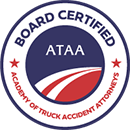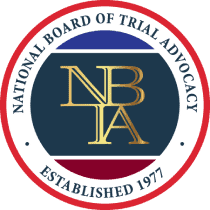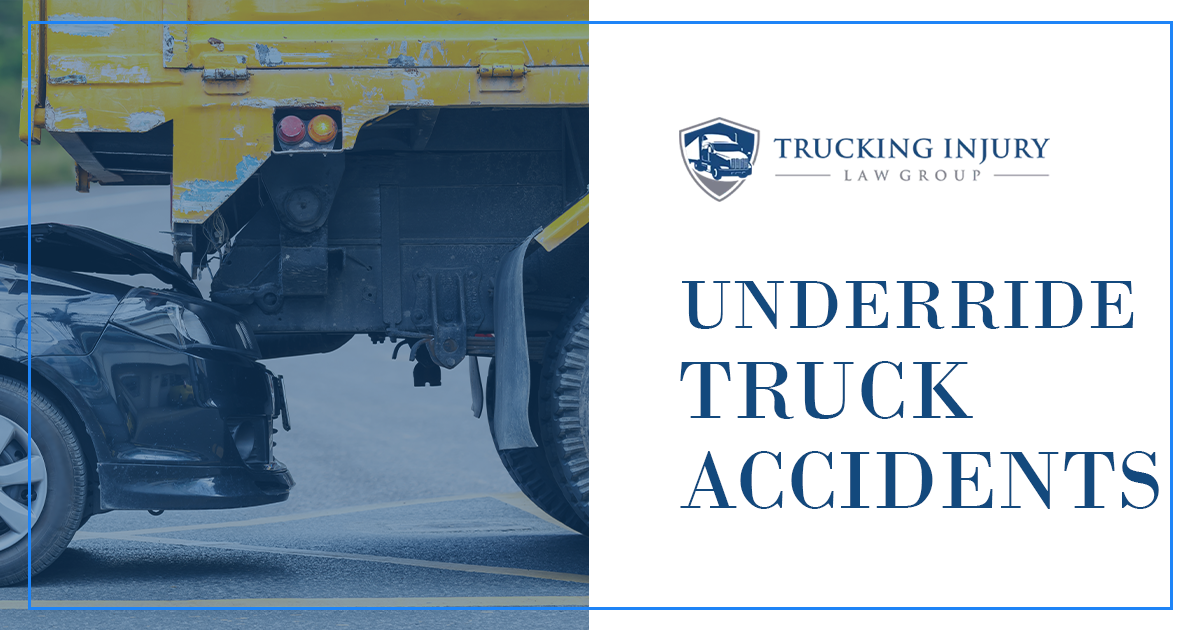Underride Truck Accidents
When it comes to different types of collisions involving tractor-trailers, underride truck accidents are one of the deadliest types. During 2021, more than 400 people died in underrides, according to an analysis of National Highway Traffic Safety Administration (NHTSA) data by researchers for the Public Broadcasting Service (PBS) program Frontline. In these cases, the smaller vehicle slides under the larger one, often crushing and severely injuring all occupants.
Unfortunately, these accidents often lead to severe injuries and even death in many cases. Victims are left with substantial medical bills, loss of income, and permanent injuries. Often, families must face unexpected funeral costs and loss of companionship as a result of the incidents.
Contact the Trucking Injury Law Group today if you have been affected by an underride crash. Our team is here to help you learn more about your legal options and get the compensation you may qualify to receive in cases like these.
Underride Truck Crashes Lead to Tragic Injuries
When a smaller vehicle slides under the body of a large truck or trailer, that is known as an underride accident, according to NHTSA. These collisions often lead to serious injuries and fatalities due to the significant difference in height and size of the automobiles involved. There are two different types of underride accidents: rear and side.
It is considered a side underride accident when the smaller vehicle slides under the side of the trailer. On the other hand, rear undersides occur when a passenger car collides with the truck from the back, sliding underneath its trailer. Usually, the driver and front-seat passenger are the most affected, with injuries to their heads and upper bodies.
Common Underride Accident Injuries
Unfortunately, many individuals who experience an underride accident are left with lifelong injuries, and many times, these occupants are killed as a result. Smaller vehicles are often crushed underneath the weight of the trailer. If they do survive, they may have injuries stemming from trucking accidents like these, such as:
- Traumatic brain injuries (TBIs), concussions, and neck fractures
- Rib fractures, lung contusions, and damage to internal organs
- Spinal fractures, herniated discs, and damage to the spinal cord
- Fractures, dislocations, and soft tissue injuries
If you have suffered any of these injuries or lost a loved one due to an underride accident, you may have options. You may be able to file a claim against the party responsible for these incidents. We can help you learn more about the legal avenues you may be able to pursue at the Trucking Injury Law Group.
Reckless and Neglectful Behavior Cause These Collisions
In many of these cases, truckers are at fault for these accidents. Every driver has the responsibility to keep everyone safe on the road. If they brake suddenly or swerve into another lane, it can lead to these disastrous results, but there are plenty of other scenarios that can as well. Let’s examine a few other situations that can result in an underride accident. Those include:
Poor Brake Maintenance
When the brake lights on a truck or trailer are broken or malfunctioning, drivers behind the truck might not know when that vehicle slows down or stops. This can lead to a higher risk of rear-end collisions and underride accidents. All motorists rely on the brake lights of others to gauge a vehicle’s movements and adjust their own speed. Without clear brake signals, the car that’s following it may not have enough time to react.
Trucking companies and their drivers are responsible for ensuring that all safety components are properly working. When they fail to do so, they can potentially be held liable for any damages others suffer in an accident.
Distracted Driving
When any driver is on the road, they need to pay attention to road conditions, traffic, and others around them. Texting, talking on the phone, or looking at another device is reckless behavior. All it takes is a split second for an underride accident to occur. Sudden stops or unexpected maneuvers can lead to a car sliding under a large truck. It is up to truckers to remain alert when handling these massive vehicles.
Inexperienced Drivers
Additionally, it is the responsibility of the trucking company to make sure their drivers are properly trained and equipped to maneuver their big rigs. Along with distracted driving, inexperienced truckers can also be hazardous on the road. If faced with a situation, such as a sudden stop in front of them, they are more likely to act recklessly, causing injuries to others around them. All truck drivers should stay alert, avoid distractions, and be prepared for any situation on the road.
Inadequate Underside Protection
Today, there are safety features that can keep everyone safe. Many trucks have underride guards installed on their sides and rear to prevent these crashes from occurring. However, not all trailers have them. Without these guards, there is a high risk of the car’s front end and passenger compartment getting crushed in the event of a collision with a truck.
Poor Visibility
Limited sight distance is a safety concern for truck drivers and other motorists on the road. Poor visibility can happen for several reasons, such as night blindness, adverse weather conditions, and inadequate lighting. When a truck or trailer is difficult to see, it increases the risk of underride accidents.
An 18-wheeler not equipped with properly functioning headlights, taillights, and reflective markings reduces its visibility, especially in low-light conditions. While no one can control the weather, governmental entities can potentially be at fault for these accidents if inadequate signage or lighting results in a collision.
Determining Fault and Seeking Compensation
In these cases, taking legal action is one way to recover compensation for any losses stemming from the accident. If the truck driver or the trucking company is found negligent through inadequate maintenance, failure to signal, or reckless driving, you may be able to hold them liable. In negligence cases like these, defendants may be required to compensate victims and their families for any injury-related losses or damages they sustain.
Inaction can also lead to a personal injury or wrongful death lawsuit. They could be liable if the truck driver didn’t maintain these safety features. Proper maintenance and regular inspections can prevent accidents and ensure accountability.
If the truck lacks proper underride guards, the trucking company may be held responsible for not ensuring adequate safety measures. However, sometimes the manufacturer may be responsible for a defective product, such as if the guards don’t perform as expected and it leads to accidents with injuries.
Poorly designed roads, inadequate signage, or lack of proper lighting can contribute to underride accidents. In these cases, government entities responsible for road maintenance may share liability.
Compensation You May Be Entitled to After an Underride Truck Crash
Underride truck accidents can have devastating consequences for the victims and their families. Most of the time, these individuals may be entitled to compensation for their losses, which could include:
- Medical expenses: You can seek compensation for immediate medical bills, ongoing treatments, surgeries, and any future medical needs related to the accident. Often, these costs include hospital stays, medication, rehabilitation, and therapy.
- Lost wages: If you are unable to work, either temporarily or permanently, due to the accident, you can seek compensation for lost wages and potential future earnings.
- Property damage: In these accidents, the other vehicle is usually declared totaled by the insurance company. You may be able to seek compensation for damage to your property, whether you need to repair or replace the items.
- Cost of services: In some cases, you could get reimbursement for services, such as household help, childcare, or cleaning services, especially if they are required after the accident.
- Pain and suffering: Many times, you may have trauma from the incident. In these cases, you may be able to get compensation for physical pain, emotional distress, and diminished quality of life.
If the trucking company or driver acted extremely recklessly, then the courts could award punitive damages. These monetary awards punish the defendant for this behavior.
Unfortunately, these accidents can be deadly, leading to the loss of loved ones. In these situations, the surviving family members can take legal action to recover funeral and burial costs and also seek the lost income potential of their relative.
Determining fault and liability can be complicated, especially in underride accidents. Thus, if you’ve been involved in an accident, consider consulting with our Trucking Injury Law Group team. Your initial case consultation is completely free.
How Trucking Injury Law Group Can Help You
At the Trucking Injury Law Group, we focus specifically on truck accidents, such as underride collisions. Our team is committed to delivering superior representation to truck crash victims. Through a combination of talent and experience, we work tirelessly to ensure our clients receive the compensation they rightfully deserve.
What sets the Trucking Injury Law Group apart is our proven track record in striking out-of-court settlements and winning maximum judgments for our clients at trial. We also have a strong record when it comes to outcomes in complex truck accident cases in multiple jurisdictions.
Additionally, we have a board-certified truck accident attorney, who had their credentials bestowed upon them by the National Board of Trial Advocacy (NBTA), on our staff.
If you’ve been injured or lost a loved one in an underride truck accident, reach out to the Trucking Injury Law Group for a free case evaluation. We are ready to guide you through the legal process and help you take the next step to recover compensation from those liable for the accident.










